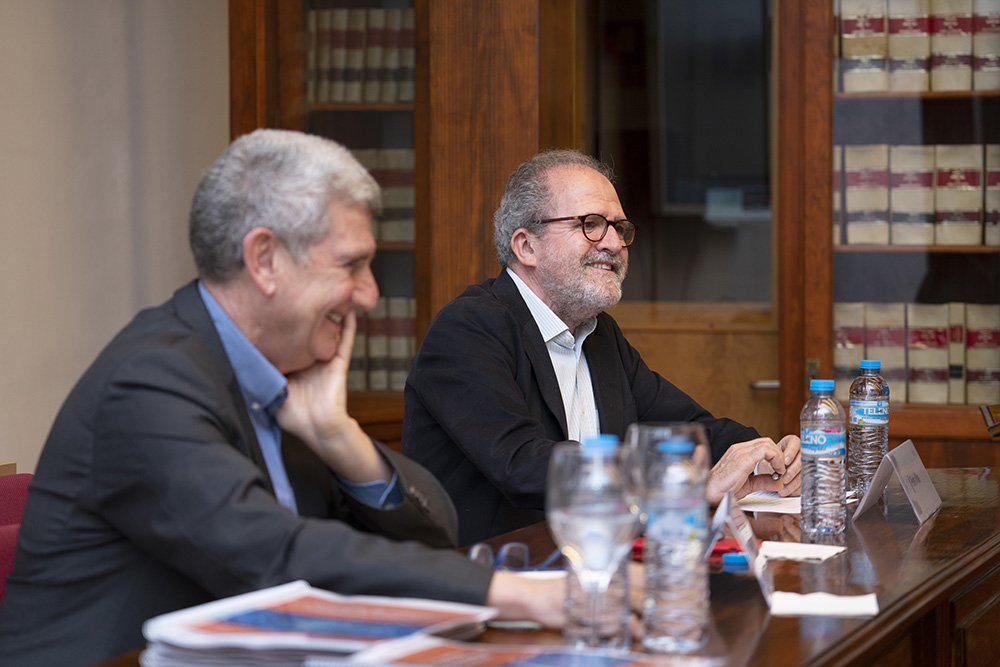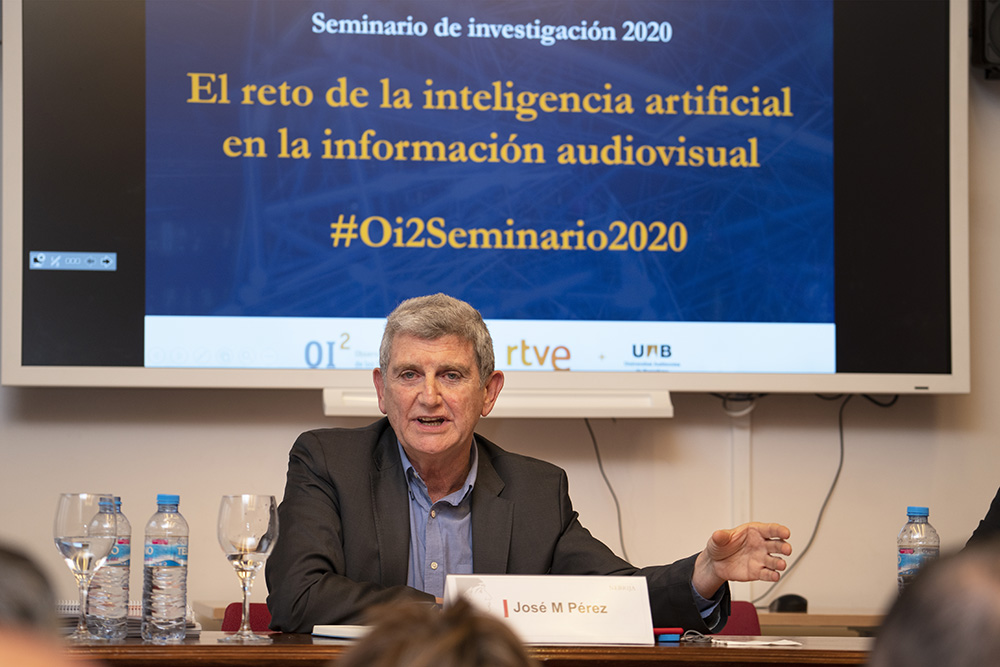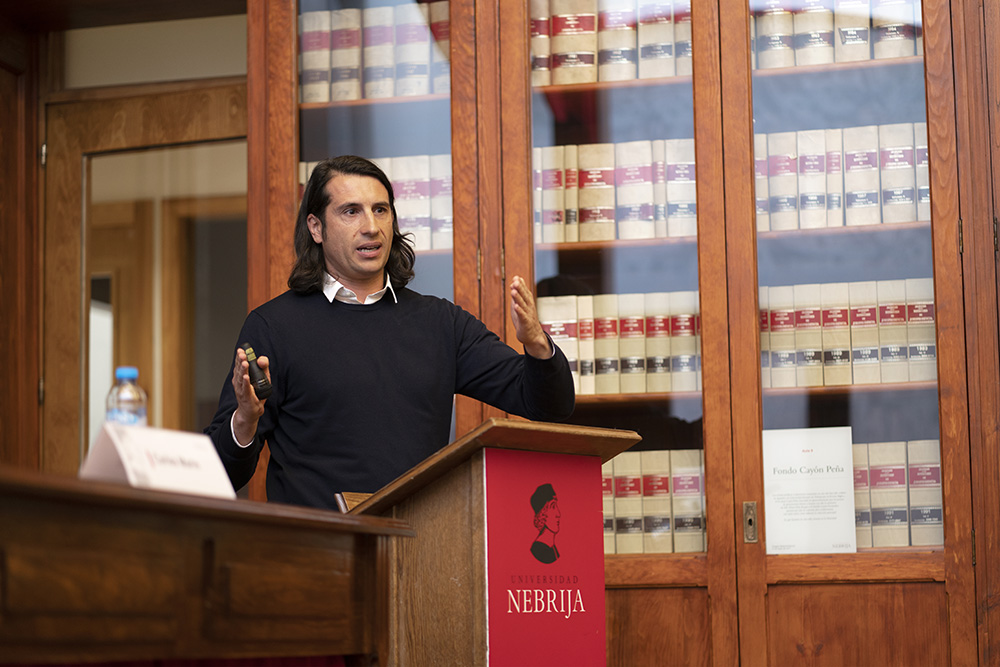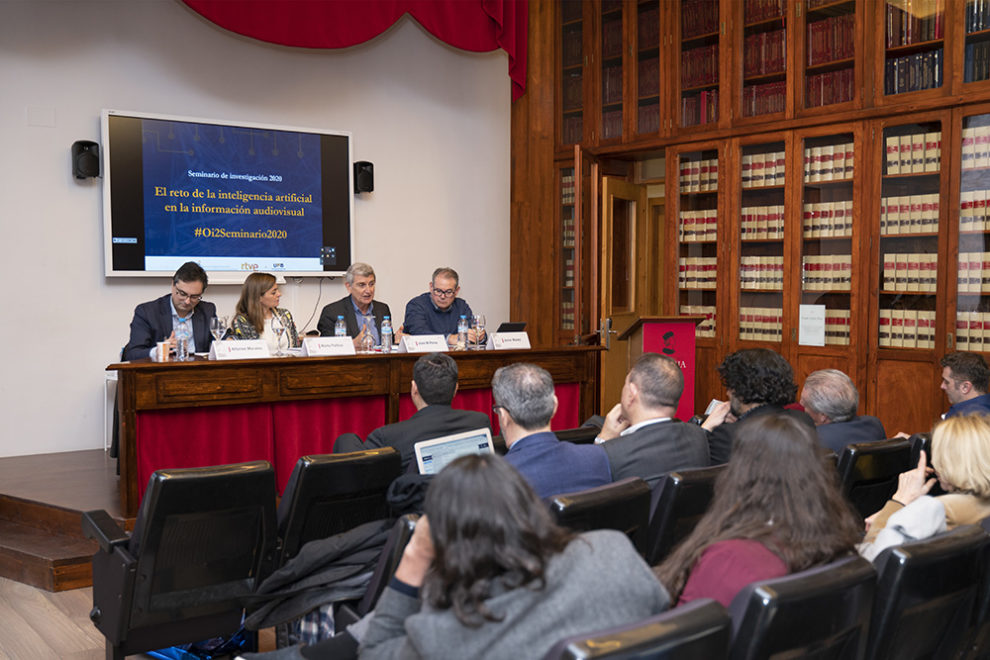The research seminar El reto de la inteligencia artificial en la información audiovisual (The challenge of artificial intelligence in audiovisual news) was held as an essential meeting to reflect on the growing use of artificial intelligence in newsrooms. The seminar, organised by the Observatory for News Innovation in the Digital Society (OI2), prompted an extensive debate on important issues such as copyright and ethics in the use of systems operated by artificial intelligence to create news. “This seminar is about sharing knowledge in an open and transparent way,” said José Manuel Pérez Tornero, director of the RTVE-UAB Chair in his opening remarks.
The seminar was divided into round tables with prominent speakers representing the different actors involved in the subject: journalists, engineers, academics and members of the industry.
During the opening, Pere Vila, RTVE’s Director of Technology Strategy and Digital Innovation, highlighted that there are five areas in which AI can be applied: news detection, information gathering, content writing and creation, publication and broadcasting, archiving, and audience reception and use.
José Manuel Pérez Tornero pointed out that artificial intelligence can become a risk or an opportunity for progress depending on how it is used. According to the Nebrija University, a partner of the event, transparency and the response of the scientific community are, for Pérez Tornero, essential on the international chessboard. “Wars have been built around oil. Oil is now artificial intelligence and in the prologue to the 21st century we have to face this battle in solidarity,” he said.

Mixed teams to ensure correct use of AI
Machines have ceased to be external and complementary tools in the construction of news to be integrated as part of the process from the very beginning. For this reason, it was stressed that it is essential to understand their capabilities and functioning through the construction of multidisciplinary newsrooms.
During the first round table, the results obtained in the research phase on news detection using AI were presented. Cristina Pulido, Serra Hunter professor at the Department of Journalism and Communication Sciences at the UAB, emphasised the need for a continuous dialogue between engineers, researchers, communication academics and journalists to establish a mutual understanding between all those involved.
Laura Cervi, postdoctoral researcher at the UAB, specified in the second round table on automatic news writing that, in addition to the dialogue between professionals, it is important to define the concepts and terms used. In this way, she recommended that it is appropriate to speak of “automated journalism” and not “robot journalism”.
AI “humanises” the profession and boosts quality journalism
During the discussions with the audience, questions were raised about copyright or the responsibility of a text made by a robot, but the fear of the journalist being replaced by a machine was one of the most common concerns. In response to this, Carmen Pérez Cernuda, deputy director of Innovation and Technological Strategy at RTVE, stated that artificial intelligence does not replace the journalist, but develops monotonous and quantitative tasks that allow the ‘human’ to save time and focus on more important and specialised aspects to increase the quality of the content.
“The media we consulted have told us that these tools improve efficiency and free journalists from tedious processes that can be done automatically. Journalists can focus on investigative and analytical tasks,” Cervi said during his speech.
Pilar Bernat, professor of New Technologies at Nebrija University, in agreement with the ideas shared by Cervi and Pérez Cernuda, added that AI “helps us to recover the human side of the profession”.
For his part, David Llorente, founder and CEO of Narrativa, a company dedicated to the automatic generation of content for the media, e-commerce and other sectors, clarified that the intention of his company is not to try to make machines write better than journalists, but to respond to immediacy and fill existing information gaps.
“These are tools that promote fast and efficient communication with regard to a particular news event,” said Gaspar Simón Prestel, coordinator of social networks in RTVE’s news services.

AI between audiences and journalism education
Beyond the ethical debate on copyright or publishing responsibility, artificial intelligence is also part of the dialogues on public television and audience participation. The third round table of the day, in collaboration with the Innonews network, was dedicated to this topic with the participation of José Manuel Pérez Tornero, Alfonso Morales, president of Radio Televisión Madrid, Javier Marzal, deputy director of the Communication Laboratory of the Jaume I University and Marta Pellico, executive director of iCmedia.
“To take on the big digital subscription platforms, you have to have a global audience like they have. You need to gather all the data they accumulate. It is an artificial intelligence that learns every day. The challenge is to think about how we are able to build this in the audiovisual media”, said Pérez Tornero and pointed out that the task of public television is to become the pilot for raising awareness of new rights for citizens and to forget about the ‘ghost’ of audiences, so that it can become a human and intelligent television.
Javier Marzal stressed that a Netflix subscription “can solve some problems, in inverted commas, but it certainly does not solve the problem of local information, nor does it solve other needs that have to do with the visibility of the economic, political, social and cultural activity of a territory. Many people are not aware that the public media are needed to take on these tasks”.
This approach represents one of the reasons why the education of future journalists is of vital importance today. The formation of a generation that understands and applies AI correctly, and at the same time rescues the audiovisual media needed by society, depends on the academic curriculum implemented in universities.
The last panel of the seminar highlighted the role of AI in the teaching of future journalists through the participation of Santiago Tejedor, director of the Department of Journalism at the UAB, Manuel Ángel Vázquez Medel, president of the Academic Committee of the Master’s Degree in Creative Writing at the University of Seville, Carles Marín, director of the Master’s Degree in TV Reportage at the Universidad Rey Juan Carlos, Martín Vaz, researcher of the Novos Medios group at the Universidad Santiago de Compostela and the moderation of Mercedes Herrero de la Fuente, PhD in Information Sciences and associate professor at the Universidad Nebrija.
Manuel Ángel Vázquez proposed creating open and courageous university plans equipped with new instruments and tools that do not stand in the way of cultivating critical, creative and ethical thinking.
“We have to strengthen professional orientation. We need students to know where they are going to be able to work and manage a context of uncertainty, to have the flexibility to adapt to a scenario that is continually changing and a capacity for self-criticism,” Tejedor stressed, adding that bridges of dialogue must be built between industry and universities to raise issues, proposals, initiatives or transcendental projects such as AI. Martín Vaz joined this approach and reminded the universities that they must inspire their students to reformulate the practice of journalism.
He also concluded that universities should include courses on data, understand that robots will also need to be taught how to generate richer and more interesting content, and understand that their essence will be more demanding, forcing journalists to be more creative.
The future: unstoppable and “fearless” change
David Corral, head of content innovation at RTVE, highlighted in his speech the positive perspectives that AI brings to the industry and assured that we should not be afraid of a change that is unstoppable. “AI allows us to go where we didn’t go before. To publish information and news about local events or sports categories that could not be covered. It fulfils our public service mandate, it is a lever”.
One of the most important conclusions highlighted by the experts is that we are at the stage of initiating a process that will be predominant in the future: “we are in the prehistory of AI“, emphasised Manuel Ángel Vázquez, so we must begin to consider, think, advance and plan the application criteria.
In this way, several speakers and attendees at the conference agreed that documentation work on the subject should be strengthened and that the discussion should focus on how to improve and advance in order to achieve greater effectiveness in the future. “We are facing a semi-automated journalism,” said Gabriel Torres, president of ATEI. “More and better research on the impact of AI is needed at this prehistoric stage,” said Tejedor.






